

Compact Muon Solenoid
LHC, CERN
| CMS-HIN-21-017 ; CERN-EP-2023-075 | ||
| Multiplicity and transverse momentum dependence of charge-balance functions in pPb and PbPb collisions at LHC energies | ||
| CMS Collaboration | ||
| 20 July 2023 | ||
| Submitted to J. High Energy Phys. | ||
| Abstract: Measurements of the charge-dependent two-particle angular correlation function in proton-lead (pPb) collisions at a nucleon-nucleon center-of-mass energy of $ \sqrt{\smash[b]{s_{_{\mathrm{NN}}}}} = $ 8.16 TeV and lead-lead (PbPb) collisions at $ \sqrt{\smash[b]{s_{_{\mathrm{NN}}}}} = $ 5.02 TeV are reported. The pPb and PbPb datasets correspond to integrated luminosities of 186 nb$^{-1}$ and 0.607 nb$^{-1}$, respectively, and were collected using the CMS detector at the CERN LHC. The charge-dependent correlations are characterized by balance functions of same- and opposite-sign particle pairs. The balance functions, which contain information about the creation time of charged particle pairs and the development of collectivity, are studied as functions of relative pseudorapidity ($ \Delta \eta $) and relative azimuthal angle ($ \Delta \phi $), for various multiplicity and transverse momentum ($ p_{\mathrm{T}} $) intervals. A multiplicity dependence of the balance function is observed in $ \Delta \eta $ and $ \Delta \phi $ for both systems. The width of the balance functions decreases towards high-multiplicity collisions in the momentum region $ < $2 GeV, for pPb and PbPb results. No multiplicity dependence is observed at higher transverse momentum. The data are compared with HYDJET, HIJING and AMPT generator predictions, none of which capture completely the multiplicity dependence seen in the data. | ||
| Links: e-print arXiv:2307.11185 [nucl-ex] (PDF) ; CDS record ; inSPIRE record ; CADI line (restricted) ; | ||
| Figures | |
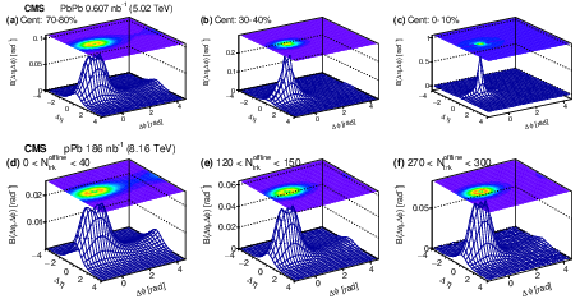
png pdf |
Figure 1:
The balance function is shown in terms of $ \Delta \eta $ and $ \Delta \phi $ in PbPb collisions at $ \sqrt{\smash[b]{s_{_{\mathrm{NN}}}}} = $ 5.02 TeV (upper panels) and for pPb collisions at 8.16 TeV (lower panels). From left to right, the results are shown for the centrality classes in PbPb ($ N_\text{trk}^\text{offline} $ multiplicity in pPb) of 70-80, 30-40, 0-10% (0-40, 120-150, 270-300). The trigger and associated particles in PbPb (pPb) collisions satisfy the condition 0.5 (0.4) $ < p_\text{T,asso} < p_\text{T,trig} < $ 2.0 GeV. |

png pdf |
Figure 1-a:
The balance function is shown in terms of $ \Delta \eta $ and $ \Delta \phi $ in PbPb collisions at $ \sqrt{\smash[b]{s_{_{\mathrm{NN}}}}} = $ 5.02 TeV. From left to right, the results are shown for the centrality classes in PbPb of 70-80, 30-40, 0-10%. The trigger and associated particles satisfy the condition 0.5 $ < p_\text{T,asso} < p_\text{T,trig} < $ 2.0 GeV. |

png pdf |
Figure 1-b:
The balance function is shown in terms of $ \Delta \eta $ and $ \Delta \phi $ for pPb collisions at 8.16 TeV. From left to right, the results are shown $ N_\text{trk}^\text{offline} $ multiplicity of 70-80, 30-40, 0-10%. The trigger and associated particles satisfy the condition 0.4 $ < p_\text{T,asso} < p_\text{T,trig} < $ 2.0 GeV. |

png pdf |
Figure 2:
The projection of the balance function is presented in the upper panel for PbPb (lower panel for pPb) collisions as a function of $ \Delta\eta $ (left column) and in $ \Delta\phi $ (right column). The statistical uncertainties of the data points are smaller than the marker size and rectangular boxes indicate the systematic uncertainties. |
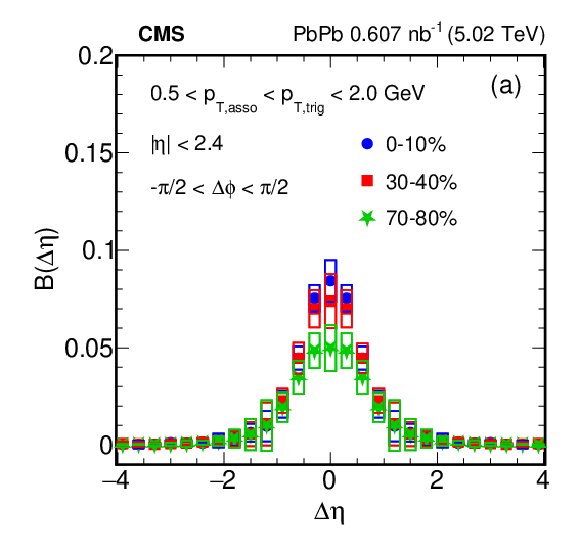
png pdf |
Figure 2-a:
The projection of the balance function is presented for PbPb collisions as a function of $ \Delta\eta $. The statistical uncertainties of the data points are smaller than the marker size and rectangular boxes indicate the systematic uncertainties. |
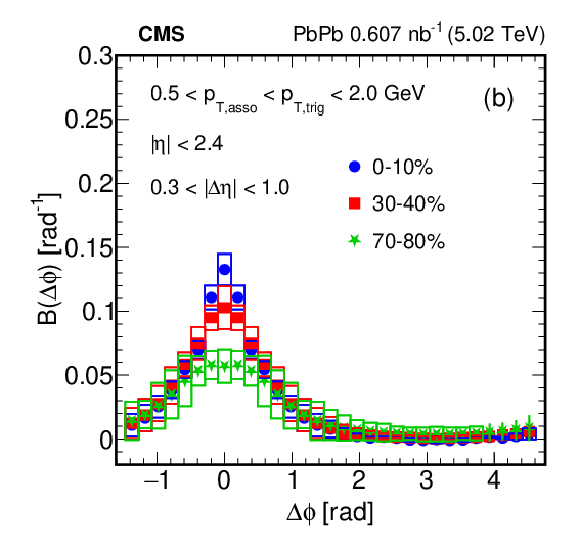
png pdf |
Figure 2-b:
The projection of the balance function is presented for PbPb collisions as a function of $ \Delta\phi $. The statistical uncertainties of the data points are smaller than the marker size and rectangular boxes indicate the systematic uncertainties. |
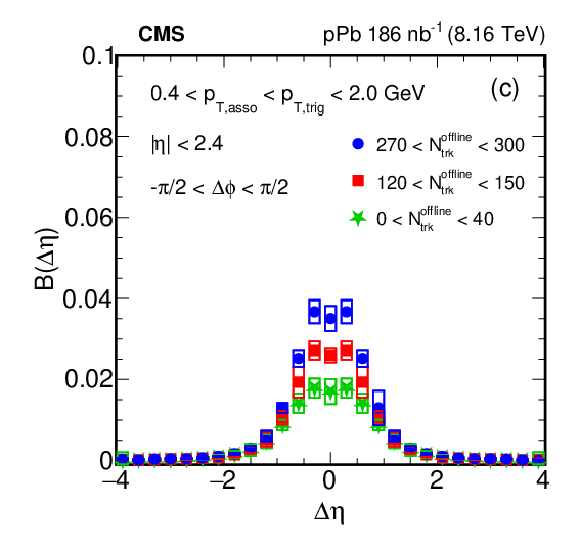
png pdf |
Figure 2-c:
The projection of the balance function is presented for pPb collisions as a function of $ \Delta\eta $. The statistical uncertainties of the data points are smaller than the marker size and rectangular boxes indicate the systematic uncertainties. |

png pdf |
Figure 2-d:
The projection of the balance function is presented for pPb collisions as a function of $ \Delta\phi $. The statistical uncertainties of the data points are smaller than the marker size and rectangular boxes indicate the systematic uncertainties. |

png pdf |
Figure 3:
The width of the balance function in $ \langle |\Delta \eta| \rangle $ and the ratio of $ \langle |\Delta \eta| \rangle/ \langle |\Delta \eta| \rangle_{N_\text{ch} < 65} $ and $ \langle |\Delta \eta| \rangle / \langle |\Delta \eta| \rangle_{N_\text{ch} < 24} $ are shown as functions of $ N_\text{ch} $ for PbPb collisions in $ \sqrt{\smash[b]{s_{_{\mathrm{NN}}}}} = $ 5.02 TeV (upper panels) and pPb collisions in $ \sqrt{\smash[b]{s_{_{\mathrm{NN}}}}} = $ 8.16 TeV (lower panels), respectively. The statistical uncertainties of the data points are smaller than the marker size and rectangular boxes indicate the systematic uncertainties. |
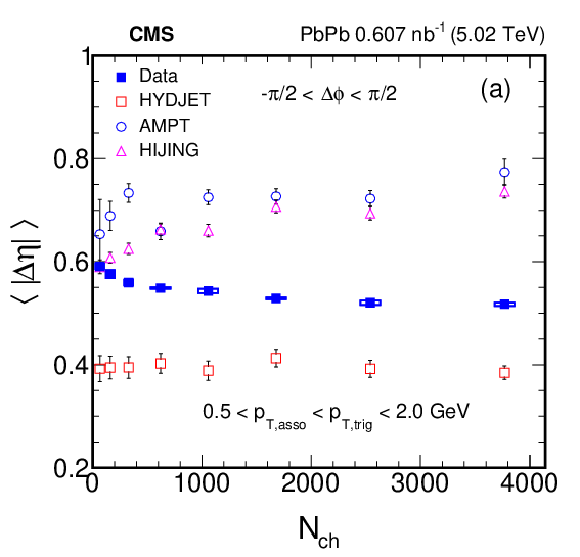
png pdf |
Figure 3-a:
The width of the balance function in $ \langle |\Delta \eta| \rangle $ is shown as a function of $ N_\text{ch} $ for PbPb collisions in $ \sqrt{\smash[b]{s_{_{\mathrm{NN}}}}} = $ 5.02 TeV. The statistical uncertainties of the data points are smaller than the marker size and rectangular boxes indicate the systematic uncertainties. |
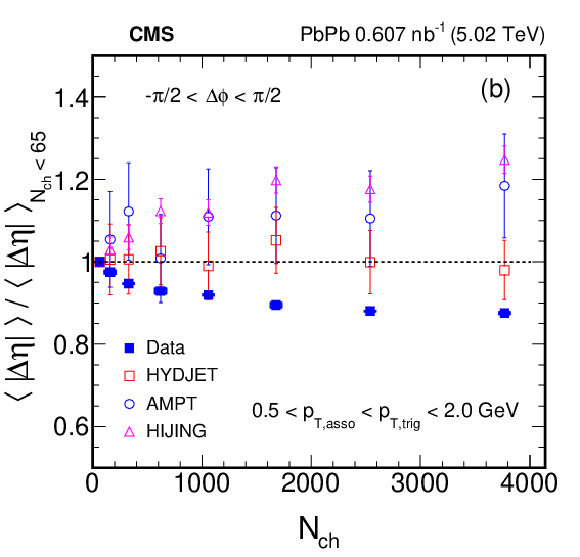
png pdf |
Figure 3-b:
The width of the balance function in $ \langle |\Delta \eta| \rangle $ is shown as a function of $ N_\text{ch} $ for pPb collisions in $ \sqrt{\smash[b]{s_{_{\mathrm{NN}}}}} = $ 8.16 TeV. The statistical uncertainties of the data points are smaller than the marker size and rectangular boxes indicate the systematic uncertainties. |

png pdf |
Figure 3-c:
The ratio of $ \langle |\Delta \eta| \rangle/ \langle |\Delta \eta| \rangle_{N_\text{ch} < 65} $ and $ \langle |\Delta \eta| \rangle / \langle |\Delta \eta| \rangle_{N_\text{ch} < 24} $ is shown as a function of $ N_\text{ch} $ for PbPb collisions in $ \sqrt{\smash[b]{s_{_{\mathrm{NN}}}}} = $ 5.02 TeV. The statistical uncertainties of the data points are smaller than the marker size and rectangular boxes indicate the systematic uncertainties. |

png pdf |
Figure 3-d:
The ratio of $ \langle |\Delta \eta| \rangle/ \langle |\Delta \eta| \rangle_{N_\text{ch} < 65} $ and $ \langle |\Delta \eta| \rangle / \langle |\Delta \eta| \rangle_{N_\text{ch} < 24} $ is shown as a function of $ N_\text{ch} $ for pPb collisions in $ \sqrt{\smash[b]{s_{_{\mathrm{NN}}}}} = $ 8.16 TeV. The statistical uncertainties of the data points are smaller than the marker size and rectangular boxes indicate the systematic uncertainties. |
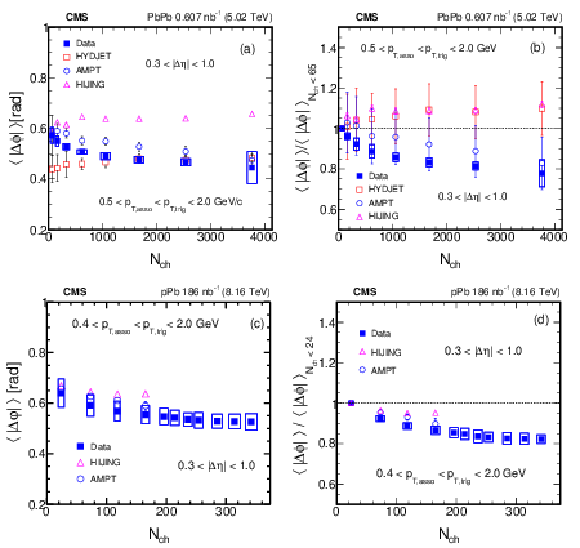
png pdf |
Figure 4:
The width of the balance function in $ \langle |\Delta \phi| \rangle $ and the ratios of $ \langle |\Delta \phi| \rangle/\langle |\Delta \phi| \rangle_{N_\text{ch} < 65} $ and $ \langle |\Delta \phi| \rangle/ \langle |\Delta \phi| \rangle_{N_\text{ch} < 24} $ are shown as functions of $ N_\text{ch} $ for PbPb collisions in $ \sqrt{\smash[b]{s_{_{\mathrm{NN}}}}} = $ 5.02 TeV (upper panels) and pPb collisions in $ \sqrt{\smash[b]{s_{_{\mathrm{NN}}}}} = $ 8.16 TeV (lower panels), respectively. The statistical uncertainties of the data points are smaller than the marker size and rectangular boxes indicate the systematic uncertainties. |

png pdf |
Figure 4-a:
The width of the balance function in $ \langle |\Delta \phi| \rangle $ is shown as a function of $ N_\text{ch} $ for PbPb collisions in $ \sqrt{\smash[b]{s_{_{\mathrm{NN}}}}} = $ 5.02 TeV. The statistical uncertainties of the data points are smaller than the marker size and rectangular boxes indicate the systematic uncertainties. |

png pdf |
Figure 4-b:
The width of the balance function in $ \langle |\Delta \phi| \rangle $ is shown as a function of $ N_\text{ch} $ for PbPb collisions in $ \sqrt{\smash[b]{s_{_{\mathrm{NN}}}}} = $ 5.02 TeV. The statistical uncertainties of the data points are smaller than the marker size and rectangular boxes indicate the systematic uncertainties. |
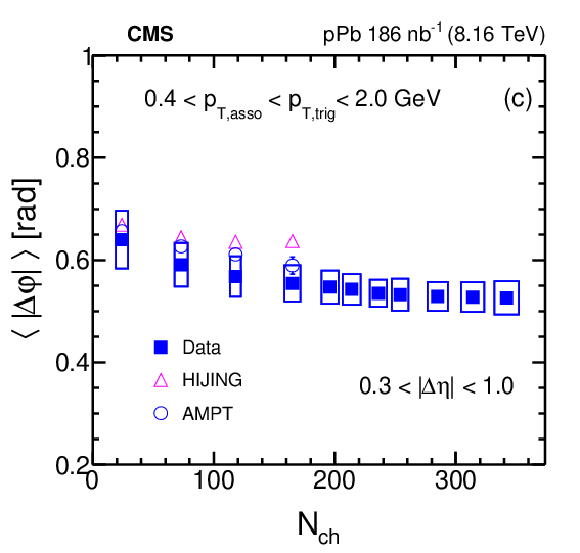
png pdf |
Figure 4-c:
The ratios of $ \langle |\Delta \phi| \rangle/\langle |\Delta \phi| \rangle_{N_\text{ch} < 65} $ and $ \langle |\Delta \phi| \rangle/ \langle |\Delta \phi| \rangle_{N_\text{ch} < 24} $ is shown as a function of $ N_\text{ch} $ for pPb collisions in $ \sqrt{\smash[b]{s_{_{\mathrm{NN}}}}} = $ 8.16 TeV. The statistical uncertainties of the data points are smaller than the marker size and rectangular boxes indicate the systematic uncertainties. |
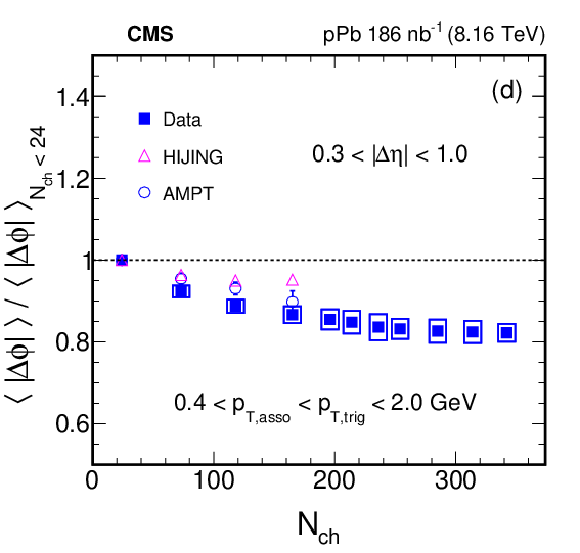
png pdf |
Figure 4-d:
The ratios of $ \langle |\Delta \phi| \rangle/\langle |\Delta \phi| \rangle_{N_\text{ch} < 65} $ and $ \langle |\Delta \phi| \rangle/ \langle |\Delta \phi| \rangle_{N_\text{ch} < 24} $ is shown as a function of $ N_\text{ch} $ for pPb collisions in $ \sqrt{\smash[b]{s_{_{\mathrm{NN}}}}} = $ 8.16 TeV. The statistical uncertainties of the data points are smaller than the marker size and rectangular boxes indicate the systematic uncertainties. |
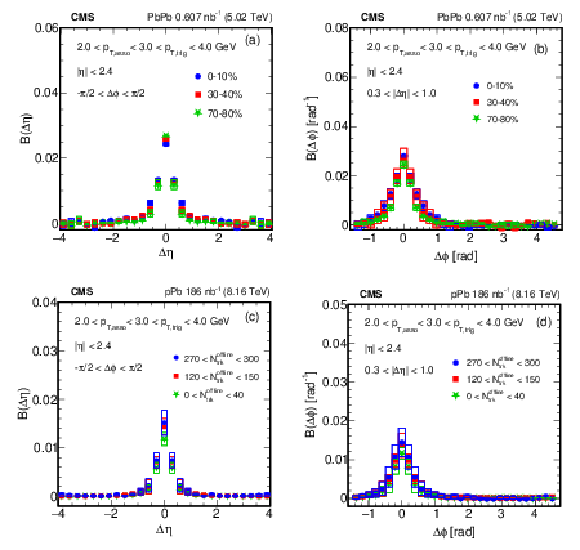
png pdf |
Figure 5:
The projection of the balance function is presented for PbPb in $ \sqrt{\smash[b]{s_{_{\mathrm{NN}}}}} = $ 5.02 TeV (upper panels) and pPb in $ \sqrt{\smash[b]{s_{_{\mathrm{NN}}}}} = $ 8.16 TeV (lower panels) collisions as a function of $ \Delta \eta $ (left column) and $ \Delta \phi $ (right column), for 2.0 $ < p_\text{T,asso} < 3.0 < p_\text{T,trig} < $ 4.0 GeV ranges. The 1D projection is derived for $ \Delta \eta $ in near-side ($ |\Delta \phi| < \pi/ $ 2) and $ \Delta \phi $ (0.3 $ < |\Delta \eta| < $ 1.0) regions. |

png pdf |
Figure 5-a:
The projection of the balance function is presented for PbPb in $ \sqrt{\smash[b]{s_{_{\mathrm{NN}}}}} = $ 5.02 TeV collisions as a function of $ \Delta \eta $, for 2.0 $ < p_\text{T,asso} < 3.0 < p_\text{T,trig} < $ 4.0 GeV ranges. The 1D projection is derived in the near-side ($ |\Delta \phi| < \pi/ $ 2) region. |

png pdf |
Figure 5-b:
The projection of the balance function is presented for PbPb in $ \sqrt{\smash[b]{s_{_{\mathrm{NN}}}}} = $ 5.02 TeV collisions as a function of $ \Delta \phi $, for 2.0 $ < p_\text{T,asso} < 3.0 < p_\text{T,trig} < $ 4.0 GeV ranges. The 1D projection is derived in the 0.3 $ < |\Delta \eta| < $ 1.0 region. |

png pdf |
Figure 5-c:
The projection of the balance function is presented for pPb in $ \sqrt{\smash[b]{s_{_{\mathrm{NN}}}}} = $ 8.16 TeV collisions as a function of $ \Delta \eta $, for 2.0 $ < p_\text{T,asso} < 3.0 < p_\text{T,trig} < $ 4.0 GeV ranges. The 1D projection is derived in the near-side ($ |\Delta \phi| < \pi/ $ 2) region. |

png pdf |
Figure 5-d:
The projection of the balance function is presented for pPb in $ \sqrt{\smash[b]{s_{_{\mathrm{NN}}}}} = $ 8.16 TeV collisions as a function of $ \Delta \phi $, for 2.0 $ < p_\text{T,asso} < 3.0 < p_\text{T,trig} < $ 4.0 GeV ranges. The 1D projection is derived in the 0.3 $ < |\Delta \eta| < $ 1.0 region. |

png pdf |
Figure 6:
The projection of the balance function is presented for PbPb in $ \sqrt{\smash[b]{s_{_{\mathrm{NN}}}}} = $ 5.02 TeV (upper panels) and pPb in $ \sqrt{\smash[b]{s_{_{\mathrm{NN}}}}} = $ 8.16 TeV (lower panels) collisions as a function of $ \Delta \eta $ (left column) and $ \Delta \phi $ (right column), for 3.0 $ < p_\text{T,asso} < $ 8.0 $< p_\text{T,trig} < $ 15.0 GeV ranges. The 1D projection is derived for $ \Delta \eta $ in near-side ($ |\Delta \phi| < \pi/ $ 2) and $ \Delta \phi $ (0.3 $ < |\Delta \eta| < $ 1.0) regions. |
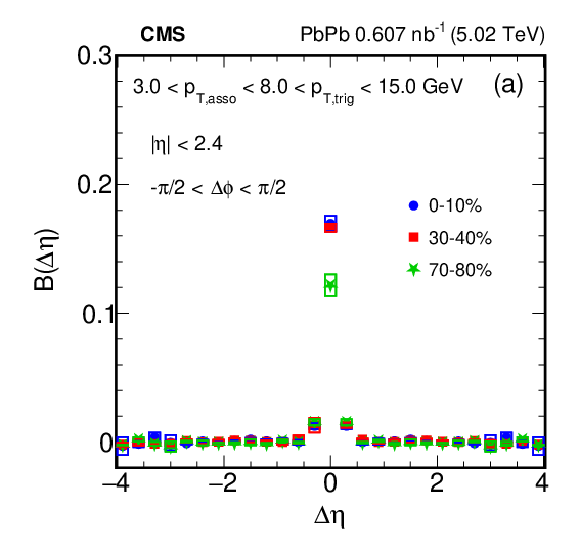
png pdf |
Figure 6-a:
The projection of the balance function is presented for PbPb in $ \sqrt{\smash[b]{s_{_{\mathrm{NN}}}}} = $ 5.02 TeV collisions as a function of $ \Delta \eta $, for 3.0 $ < p_\text{T,asso} < $ 8.0 $< p_\text{T,trig} < $ 15.0 GeV ranges. The 1D projection is derived in the near-side ($ |\Delta \phi| < \pi/ $ 2) region. |
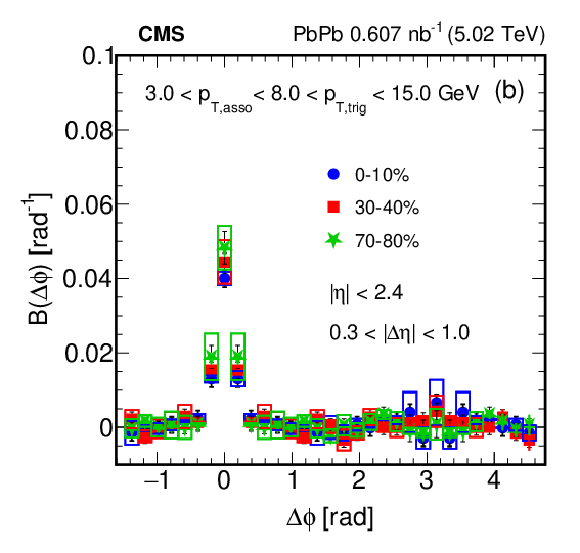
png pdf |
Figure 6-b:
The projection of the balance function is presented for PbPb in $ \sqrt{\smash[b]{s_{_{\mathrm{NN}}}}} = $ 5.02 TeV collisions as a function of $ \Delta \phi $, for 3.0 $ < p_\text{T,asso} < $ 8.0 $< p_\text{T,trig} < $ 15.0 GeV ranges. The 1D projection is derived in the 0.3 $ < |\Delta \eta| < $ 1.0 region. |
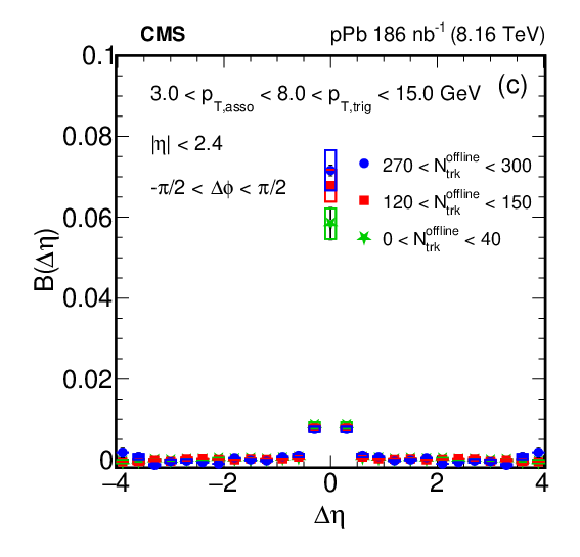
png pdf |
Figure 6-c:
The projection of the balance function is presented for pPb in $ \sqrt{\smash[b]{s_{_{\mathrm{NN}}}}} = $ 8.16 TeV collisions as a function of $ \Delta \eta $, for 3.0 $ < p_\text{T,asso} < $ 8.0 $< p_\text{T,trig} < $ 15.0 GeV ranges. The 1D projection is derived in the near-side ($ |\Delta \phi| < \pi/ $ 2) region. |
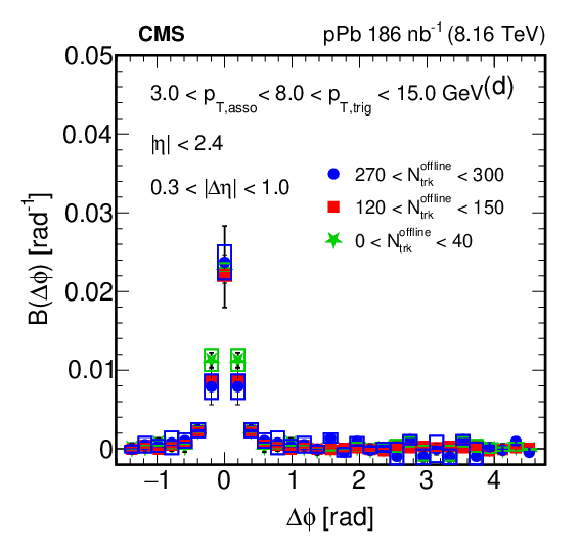
png pdf |
Figure 6-d:
The projection of the balance function is presented for pPb in $ \sqrt{\smash[b]{s_{_{\mathrm{NN}}}}} = $ 8.16 TeV collisions as a function of $ \Delta \phi $, for 3.0 $ < p_\text{T,asso} < $ 8.0 $< p_\text{T,trig} < $ 15.0 GeV ranges. The 1D projection is derived in the 0.3 $ < |\Delta \eta| < $ 1.0 region. |

png pdf |
Figure 7:
The width of the balance function in $ \Delta \eta $ (left column) and $ \Delta \phi $ (right column) is calculated for different $ p_{\mathrm{T}} $ interval in PbPb in $ \sqrt{\smash[b]{s_{_{\mathrm{NN}}}}} = $ 5.02 TeV (upper panels) and pPb collisions in $ \sqrt{\smash[b]{s_{_{\mathrm{NN}}}}} = $ 8.16 TeV (lower panels). The vertical lines indicate the statistical uncertainties of the data points, and the rectangular boxes indicate the systematic uncertainties. |

png pdf |
Figure 7-a:
The width of the balance function in $ \Delta \eta $ is calculated for different $ p_{\mathrm{T}} $ interval in PbPb in $ \sqrt{\smash[b]{s_{_{\mathrm{NN}}}}} = $ 5.02 TeV. The vertical lines indicate the statistical uncertainties of the data points, and the rectangular boxes indicate the systematic uncertainties. |

png pdf |
Figure 7-b:
The width of the balance function in $ \Delta \phi $ is calculated for different $ p_{\mathrm{T}} $ interval in PbPb in $ \sqrt{\smash[b]{s_{_{\mathrm{NN}}}}} = $ 5.02 TeV. The vertical lines indicate the statistical uncertainties of the data points, and the rectangular boxes indicate the systematic uncertainties. |

png pdf |
Figure 7-c:
The width of the balance function in $ \Delta \eta $ is calculated for different $ p_{\mathrm{T}} $ interval in pPb collisions in $ \sqrt{\smash[b]{s_{_{\mathrm{NN}}}}} = $ 8.16 TeV. The vertical lines indicate the statistical uncertainties of the data points, and the rectangular boxes indicate the systematic uncertainties. |

png pdf |
Figure 7-d:
The width of the balance function in $ \Delta \phi $ is calculated for different $ p_{\mathrm{T}} $ interval in pPb collisions in $ \sqrt{\smash[b]{s_{_{\mathrm{NN}}}}} = $ 8.16 TeV. The vertical lines indicate the statistical uncertainties of the data points, and the rectangular boxes indicate the systematic uncertainties. |
| Tables | |

png pdf |
Table 1:
Corrected average $ N_\text{ch} $ ($ \langle N_\text{ch} \rangle $) values, calculated for different multiplicities in PbPb collisions at $ \sqrt{\smash[b]{s_{_{\mathrm{NN}}}}} = $ 5.02 TeV and in pPb collisions at 8.16 TeV. |
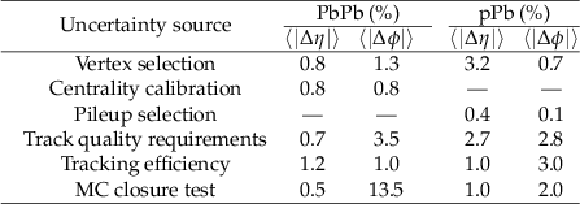
png pdf |
Table 2:
Summary of percentage systematic uncertainties calculated in $ \langle |\Delta \eta| \rangle $ and $ \langle |\Delta\phi| \rangle $ for PbPb collisions at $ \sqrt{\smash[b]{s_{_{\mathrm{NN}}}}} = $ 5.02 TeV and pPb collisions at 8.16 TeV. |
| Summary |
| This paper presents a measurement of the charge-balance function for nonidentified charged particles in proton-lead (pPb) and lead-lead (PbPb) collisions using the broad pseudorapidity coverage of the CMS detector. For both systems, the dependence of the balance function on relative pseudorapidity ($ \Delta\eta $) and relative azimuthal angle $ \Delta\phi $ of particle pairs is studied for different multiplicity classes and transverse momentum ($ p_{\mathrm{T}} $) ranges. It is observed that the width in both $ \Delta\eta $ and $ \Delta\phi $ decreases with charged particle multiplicity ($ N_\text{ch} $) in pPb and PbPb systems for $ p_{\mathrm{T}} < $ 2 GeV. These results are consistent with the system possessing a large radial flow, with particle creation at a later stage of the collision, or both. The multiplicity dependence is weaker for higher $ p_{\mathrm{T}} $ as compared with the $ p_{\mathrm{T}} < $ 2 GeV region, which implies that the balancing partners are strongly correlated. The data are compared with HYDJET, HIJING and AMPT generator predictions, none of which capture completely the multiplicity dependence seen in the data. |
| References | ||||
| 1 | BRAHMS Collaboration | Quark gluon plasma and color glass condensate at RHIC? The perspective from the BRAHMS experiment | Nucl. Phys. A 757 (2005) 1 | nucl-ex/0410020 |
| 2 | PHOBOS Collaboration | The PHOBOS perspective on discoveries at RHIC | Nucl. Phys. A 757 (2005) 28 | nucl-ex/0410022 |
| 3 | STAR Collaboration | Experimental and theoretical challenges in the search for the quark gluon plasma: The STAR Collaboration's critical assessment of the evidence from RHIC collisions | Nucl. Phys. A 757 (2005) 102 | nucl-ex/0501009 |
| 4 | PHENIX Collaboration | Formation of dense partonic matter in relativistic nucleus-nucleus collisions at RHIC: Experimental evaluation by the PHENIX Collaboration | Nucl. Phys. A 757 (2005) 184 | nucl-ex/0410003 |
| 5 | B. Müller, J. Schukraft, and B. Wysłouch | First results from PbPb collisions at the LHC | Annu. Rev. Nucl. Part. Sci. 62 (2012) 361 | 1202.3233 |
| 6 | N. Armesto and E. Scomparin | Heavy-ion collisions at the Large Hadron Collider: A review of the results from Run 1 | Eur. Phys. J. Plus 131 (2016) 3 | 1511.02151 |
| 7 | CMS Collaboration | Measurement of long-range near-side two-particle angular correlations in pp collisions at $ \sqrt{s} = $ 13 TeV | PRL 116 (2016) 172302 | CMS-FSQ-15-002 1510.03068 |
| 8 | CMS Collaboration | Observation of long-range, near-side angular correlations in pPb collisions at the LHC | PLB 718 (2013) 795 | CMS-HIN-12-015 1210.5482 |
| 9 | NA49 Collaboration | Rapidity and energy dependence of the electric charge correlations in A+A collisions at the SPS energies | PRC 76 (2007) 024914 | 0705.1122 |
| 10 | B. S. Kevin Dusling, Wei Li | Novel collective phenomena in high-energy proton-proton and proton-nucleus collisions | Int. J. Mod. Phys. E 25 (2016) 1630002 | 1509.07939 |
| 11 | CMS Collaboration | Long-range and short-range dihadron angular correlations in central PbPb collisions at $ \sqrt{\smash[b]{s_{_{\mathrm{NN}}}}} = $ 2.76 TeV | JHEP 07 (2011) 076 | CMS-HIN-11-001 1105.2438 |
| 12 | CMS Collaboration | Centrality dependence of dihadron correlations and azimuthal anisotropy harmonics in PbPb collisions at $ \sqrt{\smash[b]{s_{_{\mathrm{NN}}}}} = $ 2.76 TeV | EPJC 72 (2012) 5 | CMS-HIN-11-006 1201.3158 |
| 13 | CMS Collaboration | Observation of long-range, near-side angular correlations in proton-proton collisions at the LHC | JHEP 09 (2010) 091 | CMS-QCD-10-002 1009.4122 |
| 14 | E. Shuryak | Origin of the ``ridge'' phenomenon induced by jets in heavy ion collisions | PRC 76 (2007) 047901 | 0706.3531 |
| 15 | S. Pratt | General charge balance functions: A tool for studying the chemical evolution of the quark-gluon plasma | PRC 85 (2012) 014904 | 1109.3647 |
| 16 | S. P. Steffen Bass, Pawel Danielewicz | Clocking hadronization in relativistic heavy ion collisions with balance functions | PRL 85 (2000) 2689 | nucl-th/0005044 |
| 17 | CMS Collaboration | Measurement of prompt $ \mathrm{D}^0 $ and $ \overline{\mathrm{D}^0} $ meson azimuthal asymmetry and search for strong electric fields in PbPb collisions at $ \sqrt{\smash[b]{s_{_{\mathrm{NN}}}}}= $ 5.02 TeV | PLB 816 (2021) 136253 | CMS-HIN-19-008 2009.12628 |
| 18 | S. A. Voloshin | Heavy ion collisions: Correlations and Fluctuations in particle production | Conf. Ser. 50 (2006) 111 | nucl-ex/0505003 |
| 19 | STAR Collaboration | Balance functions from Au+Au, d+Au, and p+p collisions at $ \sqrt{\smash[b]{s_{_{\mathrm{NN}}}}} = $ 200 GeV | %%CITATION =.2307;%%, 2010 PRC 82 (2010) 024905 |
1005.2307 |
| 20 | ALICE Collaboration | Charge correlations using the balance function in PbPb collisions at $ \sqrt{\smash[b]{s_{_{\mathrm{NN}}}}} = $ 2.76 TeV | PLB 723 (2013) 267 | 1301.3756 |
| 21 | CMS Collaboration | The CMS experiment at the CERN LHC | JINST 3 (2008) S08004 | |
| 22 | CMS Collaboration | HEPData record for this analysis | link | |
| 23 | CMS Collaboration | Description and performance of track and primary-vertex reconstruction with the CMS tracker | JINST 9 (2014) P10009 | CMS-TRK-11-001 1405.6569 |
| 24 | CMS Collaboration | Track impact parameter resolution for the full pseudo rapidity coverage in the 2017 dataset with the CMS phase-1 pixel detector | CMS Detector Performance Note CMS-DP-2020-049, 2020 CDS |
|
| 25 | CMS Tracker Group Collaboration | The CMS Phase-1 pixel detector upgrade | JINST 16 (2021) P02027 | 2012.14304 |
| 26 | CMS Collaboration | CMS luminosity measurement using nucleus-nucleus collisions at $ \sqrt{\smash[b]{s_{_{\mathrm{NN}}}}}= $ 5.02 TeV in 2018 | CMS Physics Analysis Summary, 2022 CMS-PAS-LUM-18-001 |
CMS-PAS-LUM-18-001 |
| 27 | CMS Collaboration | Precision luminosity measurement in proton-proton collisions at $ \sqrt{s}= $ 13 TeV in 2015 and 2016 at CMS | EPJC 81 (2021) 800 | CMS-LUM-17-003 2104.01927 |
| 28 | CMS Collaboration | Performance of the CMS Level-1 trigger in proton-proton collisions at $ \sqrt{s} = $ 13 TeV | JINST 15 (2020) P10017 | CMS-TRG-17-001 2006.10165 |
| 29 | CMS Collaboration | The CMS trigger system | JINST 12 (2017) P01020 | CMS-TRG-12-001 1609.02366 |
| 30 | CMS Collaboration | Strange hadron collectivity in pPb and PbPb collisions | JHEP 05 (2023) 007 | CMS-HIN-19-004 2205.00080 |
| 31 | CMS Collaboration | Technical proposal for the Phase-II upgrade of the Compact Muon Solenoid | CMS Technical Proposal CERN-LHCC-2015-010, CMS-TDR-15-02, 2015 CDS |
|
| 32 | CMS Collaboration | CMS luminosity measurement using 2016 proton-nucleus collisions at $ \sqrt{\smash[b]{s_{_{\mathrm{NN}}}}}= $ 8.16 TeV | CMS Physics Analysis Summary, 2018 CMS-PAS-LUM-17-002 |
CMS-PAS-LUM-17-002 |
| 33 | CMS Collaboration | Observation of correlated azimuthal anisotropy fourier harmonics in pp and p+Pb collisions at the LHC | PRL 120 (2018) 092301 | CMS-HIN-16-022 1709.09189 |
| 34 | CMS Collaboration | Multiplicity and transverse momentum dependence of two- and four-particle correlations in pPb and PbPb collisions | PLB 724 (2013) 213 | CMS-HIN-13-002 1305.0609 |
| 35 | Lokhtin et al. | Heavy ion event generator HYDJET++ (hydrodynamics plus jets) | Comput. Phys. Comm. 180 (2009) 779 | 0809.2708 |
| 36 | H.-j. Xu, Z. Li, and H. Song | High-order flow harmonics of identified hadrons in 2.76A TeV PbPb collisions | PRC 93 (2016) 064905 | 1602.02029 |
| 37 | Z. Moravcova, K. Gulbrandsen, and Y. Zhou | Generic algorithm for multiparticle cumulants of azimuthal correlations in high energy nucleus collisions | PRC 103 (2021) 024913 | 2005.07974 |
| 38 | G. Bíróet al. | Introducing HIJING ++: the Heavy Ion Monte Carlo Generator for the High-Luminosity LHC Era | 1901.04220 | |
| 39 | GEANT4 Collaboration | GEANT 4 --- a simulation toolkit | NIM A 506 (2003) 250 | |
| 40 | CMS Collaboration | Observation and studies of jet quenching in PbPb collisions at $ \sqrt{\smash[b]{s_{_{\mathrm{NN}}}}}= $ 2.76 TeV | PRC 84 (2011) 024906 | CMS-HIN-10-004 1102.1957 |
| 41 | STAR Collaboration | Long range rapidity correlations and jet production in high energy nuclear collisions | PRC 80 (2009) 064912 | 0909.0191 |
| 42 | PHOBOS Collaboration | High Transverse Momentum Triggered Correlations over a Large Pseudorapidity Acceptance in $ \mathrm{Au}+\mathrm{Au} $ Collisions at $ \sqrt{\smash[b]{s_{_{\mathrm{NN}}}}}= $ 200 GeV | PRL 104 (2010) 062301 | 0903.2811 |
| 43 | S. Pratt and J. Vredevoogd | Femtoscopy in relativistic heavy ion collisions and its relation to bulk properties of QCD matter | PRC 78 (2008) 054906 | 0809.0516 |
| 44 | R. H. Brown and R. Q. Twiss | Correlation between Photons in two Coherent Beams of Light | Nature 177 (1956) 27 | |
| 45 | ALICE Collaboration | Femtoscopy of pp collisions at $ \sqrt{s}= $ 0.9 and 7 TeV at the LHC with two-pion Bose-Einstein correlations | PRD 84 (2011) 112004 | 1101.3665 |
| 46 | ALICE Collaboration | Multiplicity and transverse momentum evolution of charge-dependent correlations in pp, p-Pb, and Pb-Pb collisions at the LHC | EPJC 76 (2016) 86 | 1509.07255 |
| 47 | ALICE Collaboration | Centrality dependence of pion freeze-out radii in Pb-Pb collisions at $ \sqrt{\smash[b]{s_{_{\mathrm{NN}}}}} = $ 2.76 TeV | PRC 93 (2016) 024905 | 1507.06842 |
| 48 | I. P. Lokhtin and A. M. Snigirev | A model of jet quenching in ultrarelativistic heavy ion collisions and high-$ p_{\mathrm{T}} $ hadron spectra at RHIC | EPJC 45 (2006) 211 | hep-ph/0506189 |
| 49 | E. Gross | Trial factors for the look elsewhere effect in high energy physics | EPJC 70 (2010) 525 | 1005.1891 |
| 50 | CMS Collaboration | Decomposing transverse momentum balance contributions for quenched jets in PbPb collisions at $ \sqrt{\smash[b]{s_{_{\mathrm{NN}}}}} = $ 2.76 TeV | JHEP 11 (2016) 055 | CMS-HIN-15-011 1609.02466 |
| 51 | CMS Collaboration | Correlations between jets and charged particles in PbPb and pp collisions at $ \sqrt{\smash[b]{s_{_{\mathrm{NN}}}}} = $ 2.76 TeV | JHEP 02 (2016) 156 | CMS-HIN-14-016 1601.00079 |
| 52 | CMS Collaboration | Ridge correlation structure in high multiplicity pp collisions with CMS | JPG 38 (2011) 124051 | 1107.2196 |
| 53 | ATLAS Collaboration | Measurement of long-range pseudorapidity correlations and azimuthal harmonics in $ \sqrt{\smash[b]{s_{_{\mathrm{NN}}}}} = $ 5.02 TeV pPb collisions with the ATLAS detector | PRC 90 (2014) 044906 | 1409.1792 |

|
Compact Muon Solenoid LHC, CERN |

|

|

|

|

|

|